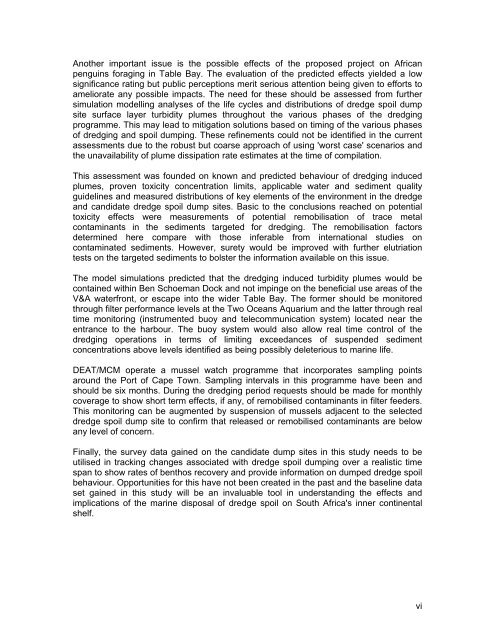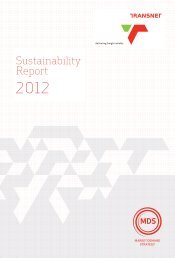BEN SCHOEMAN DOCK BERTH DEEPENING Specialist ... - Transnet
BEN SCHOEMAN DOCK BERTH DEEPENING Specialist ... - Transnet
BEN SCHOEMAN DOCK BERTH DEEPENING Specialist ... - Transnet
Create successful ePaper yourself
Turn your PDF publications into a flip-book with our unique Google optimized e-Paper software.
Another important issue is the possible effects of the proposed project on African<br />
penguins foraging in Table Bay. The evaluation of the predicted effects yielded a low<br />
significance rating but public perceptions merit serious attention being given to efforts to<br />
ameliorate any possible impacts. The need for these should be assessed from further<br />
simulation modelling analyses of the life cycles and distributions of dredge spoil dump<br />
site surface layer turbidity plumes throughout the various phases of the dredging<br />
programme. This may lead to mitigation solutions based on timing of the various phases<br />
of dredging and spoil dumping. These refinements could not be identified in the current<br />
assessments due to the robust but coarse approach of using 'worst case' scenarios and<br />
the unavailability of plume dissipation rate estimates at the time of compilation.<br />
This assessment was founded on known and predicted behaviour of dredging induced<br />
plumes, proven toxicity concentration limits, applicable water and sediment quality<br />
guidelines and measured distributions of key elements of the environment in the dredge<br />
and candidate dredge spoil dump sites. Basic to the conclusions reached on potential<br />
toxicity effects were measurements of potential remobilisation of trace metal<br />
contaminants in the sediments targeted for dredging. The remobilisation factors<br />
determined here compare with those inferable from international studies on<br />
contaminated sediments. However, surety would be improved with further elutriation<br />
tests on the targeted sediments to bolster the information available on this issue.<br />
The model simulations predicted that the dredging induced turbidity plumes would be<br />
contained within Ben Schoeman Dock and not impinge on the beneficial use areas of the<br />
V&A waterfront, or escape into the wider Table Bay. The former should be monitored<br />
through filter performance levels at the Two Oceans Aquarium and the latter through real<br />
time monitoring (instrumented buoy and telecommunication system) located near the<br />
entrance to the harbour. The buoy system would also allow real time control of the<br />
dredging operations in terms of limiting exceedances of suspended sediment<br />
concentrations above levels identified as being possibly deleterious to marine life.<br />
DEAT/MCM operate a mussel watch programme that incorporates sampling points<br />
around the Port of Cape Town. Sampling intervals in this programme have been and<br />
should be six months. During the dredging period requests should be made for monthly<br />
coverage to show short term effects, if any, of remobilised contaminants in filter feeders.<br />
This monitoring can be augmented by suspension of mussels adjacent to the selected<br />
dredge spoil dump site to confirm that released or remobilised contaminants are below<br />
any level of concern.<br />
Finally, the survey data gained on the candidate dump sites in this study needs to be<br />
utilised in tracking changes associated with dredge spoil dumping over a realistic time<br />
span to show rates of benthos recovery and provide information on dumped dredge spoil<br />
behaviour. Opportunities for this have not been created in the past and the baseline data<br />
set gained in this study will be an invaluable tool in understanding the effects and<br />
implications of the marine disposal of dredge spoil on South Africa's inner continental<br />
shelf.<br />
vi

















